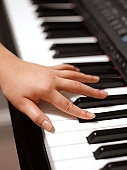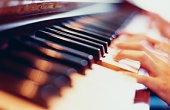
Home > Beginner Piano Lessons > Essential Piano Fingering Basics
|
||||
Essential Piano Fingering For Beginners
In this article, we will go over the essential piano fingering so that you can learn to play your chords, notes, and patterns in a more efficient and fluent manner. In piano, each finger has a number assigned to it. In most pieces, these numbers can be found beneath the notes. This helps to tell you which fingers belong on which keys so that you aren’t struggling and stretching your fingers to unnecessary extremes. The treble clef belongs to your right hand and the bass clef belongs to your left hand. To make it easier, when using a grand staff, your right hand will be performing the top staff and your left hand will be performing the bottom staff. Unlike many instruments, this is the same whether you are a right handed player or a left handed player. This means that both of your hands will require the same level of dexterity in order to perform properly. The number assigned to your thumb is the number one. This means that all of the notes you will ever see with the number one below them are to be played by your thumb. In both the treble and the bass clef, the one will be located beneath the staff itself or, in case of ledger lines, beneath the lowest ledger line.
The number assigned to your middle finger is the number three. This means that all notes with the number three underneath them and below the staff will be performed by your middle finger and your middle finger only. The number assigned to your ring finger is the number four. In all cases, the number four beneath a note will indicate that you are to play the specified note using your ring finger. The number five is assigned to your pinky finger. Whenever you see the number five below the staff and underneath a note, the note will be played by your pinky finger. In the case of chords, many times the numbers will be set side by side, from least to greatest value. In some cases the numbers may be separated by a dash. The numbers will always be modern, Americanized numbers. This means don’t mistake a Roman numeral, which dictates the piano scale degree and the chord properties, for a fingering number. In the end, the only way to become fluent with reading the essential piano fingering numbers is to practice. At first it may seem difficult to try and focus on the chord or note itself, the scale degree, the key signature, and the fingering. Over time and through practice, it will become more natural and you will have to focus less and less.
=> http://pianoplayerworld.com/Hanon1.html
| ||||
|
Although every attempt has been made to make information as accurate as possible, we are not responsible for any errors that may appear.
 Piano is all about patterns and form. While it is great to
Piano is all about patterns and form. While it is great to 
 The number assigned to your index finger is the number two. This means that all
notes with the number two below them will be performed by your index finger. The number will be located
beneath the staff itself.
The number assigned to your index finger is the number two. This means that all
notes with the number two below them will be performed by your index finger. The number will be located
beneath the staff itself.



